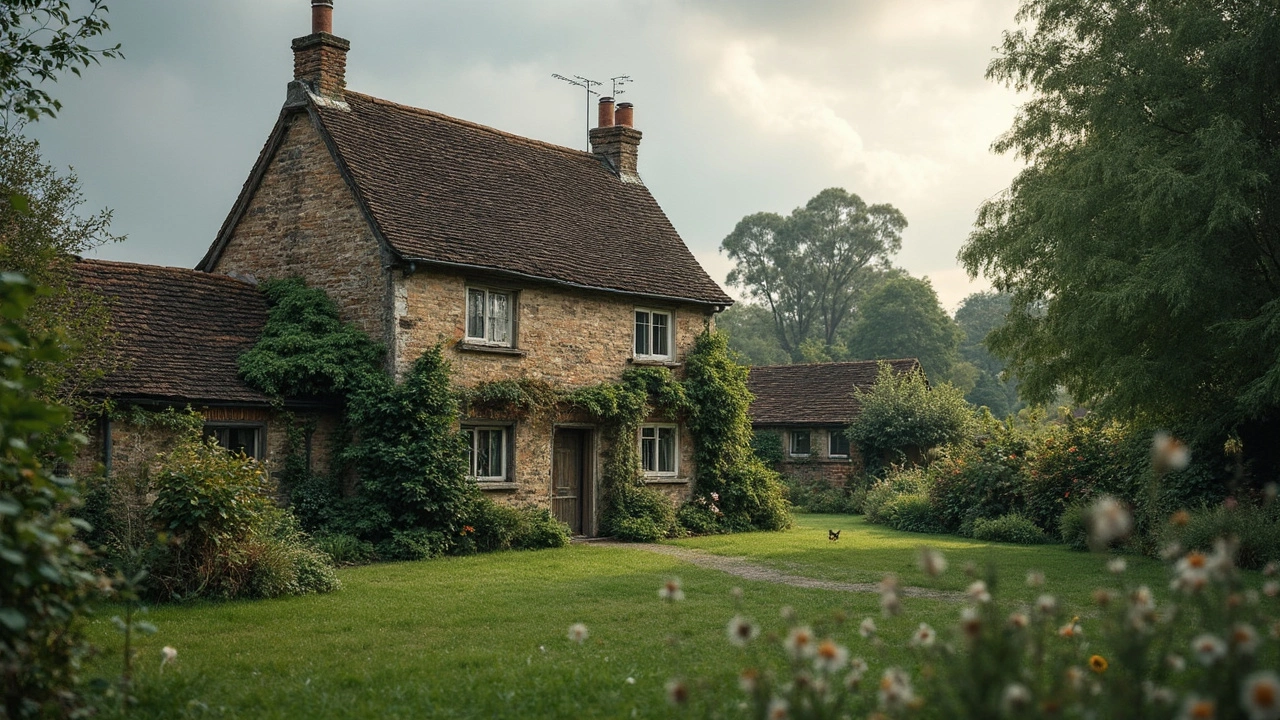Ever wonder if a house foundation can get so messed up that it's beyond fixing? You're not alone. Foundations keep our homes steady, but sometimes they get pushed to their limits. Cracking, sinking, or just acting plain weird—that's when things get tricky.
Let's kick things off by talking about why a strong foundation is a big deal. Think of it as the backbone of your house. Without it, everything else crumbles—literally. But as with most things, wear and tear happen. Soil shifts, water seeps in, or maybe you have sneaky tree roots making a mess of underground life.
So, what happens when these problems pop up? How do you know when it's serious? You're going to notice cracks in the walls or doors that don't shut right. These small signs can hint at larger issues brewing with your foundation. Early detection is key.
- The Importance of a Strong Foundation
- Common Foundation Problems
- Signs Your Foundation Needs Attention
- Professional Repair vs. DIY Solutions
- Case Studies: When Foundations Were Beyond Repair
- Tips to Prevent Foundation Damage
The Importance of a Strong Foundation
When it comes to houses, the foundation isn't just some concrete lump hiding underground. It's like the unsung hero that keeps the whole thing standing tall. A solid foundation is where it all starts. Without it, even the fanciest home with all the trimmings is at risk of turning into a pile of bricks and dust.
So, why is a strong house foundation so crucial? Think of it as the rock that supports everything above. The walls, roof, and more, all lean on this base. If you get the foundation wrong, you’re setting up for some serious problems. It acts as a safety net, making sure things stay put even when Mother Nature gets a bit wild.
Foundation repair pops up when things go south with your house's base. Whether it's due to soil movement, water intrusion, or just plain old age, issues can snowball without proper attention. A weak foundation can lead to sloping floors, sticking doors, and in worst cases, a structurally unsound home.
Here's a quick glance at what can mess up a foundation:
- Soil erosion or shifting, especially if your home sits on a hill or unstable ground.
- Water damage from leaks or poor drainage.
- Poor construction practices, using subpar materials or shortcuts.
Even the slightest bit of negligence here can wreak havoc on your property's structural integrity. That's why regular maintenance and early detection of problems are absolute musts. Regular checks and making sure that water drains away from your home can save a lot of headaches and money down the road.
A strong foundation isn’t just about preventing damage, though. It's about peace of mind. Knowing your home is on stable ground lets you sleep easy, regardless of what’s going on outside.
Common Foundation Problems
Alright, let's get into the nitty-gritty: what can actually go wrong with your house's foundation? Quite a bit, it turns out. Some problems are minor, while others can be a homeowner's nightmare. Knowing what's what gives you a fighting chance to deal with issues before they spiral out of control.
First off, cracking. You might notice tiny cracks in your foundation and think, "No biggie." But those small fissures can be a warning sign that things aren't quite right. They can result from soil expansion and contraction, usually due to moisture changes.
Another usual suspect is settlement. Houses do naturally settle over time, but if it happens unevenly, that spells trouble. You see, the ground beneath your house is a big deal. If the soil wasn't compacted well during construction or there's been significant erosion, you might see parts of your house drooping or sinking.
Then there's the water woes. Yep, water can wreak havoc on a house foundation. Poor drainage, leaking pipes, or excessive rainfall can soak the soil, making it expand and then shrink when it dries. Over time, this expansion and contraction can crack or weaken your foundation.
- Improper construction practices can lead to foundational issues. Using subpar materials or rushing the job can have long-term consequences.
- Tree roots might be silently creeping towards your foundation. If they're close enough, they exert pressure, potentially causing shifts or cracks.
- Temperature changes, especially in places with significant temperature swings, can make materials in the foundation contract and expand excessively.
Take a look at some stats here for a better picture:
| Problem | Percentage of Homes Affected |
|---|---|
| Cracking | 60% |
| Water Damage | 40% |
| Settlement | 30% |
These numbers show how common these issues are, so it's not just you—it's a common struggle. Knowing the enemy is the first step in winning the battle against foundation problems. Keep these key culprits in mind and act quickly when symptoms pop up.
Signs Your Foundation Needs Attention
We might not think about our home's foundation every day, but when something’s off, it’s best to act fast. Catching warning signs early can save you heaps of trouble and moolah. Let's dive into some telltale signs that your foundation might be throwing a fit.
First off, check those walls and ceilings. If you spot cracks, especially around door frames and windows, your house foundation might be trying to tell you something. Not all cracks are evil, but diagonal or wide ones could be a red flag.
Next up, doors and windows. Are they sticking or not latching like they used to? These might not just be quirks but indicators of shifting beneath your feet. A hard-to-budge door or window means your house might be a bit off-kilter.
If you're lucky enough to have a basement, take a stroll down there. Water stains or damp spots can mean more than just last night’s rain. Persistent moisture could be messing up your foundation over time, eating away at its strength.
Don’t forget about your floors. Uneven floors are often a sign things aren't quite right below. Roll a ball across your floor as a quick test—if it plays pinball with your furniture, you might have an issue.
Finally, keep an ear out for the whispers of foundation woes. Strange noises, like creaking or popping, can sometimes be the sounds of settling or shifting.
- Cracks in walls and ceilings
- Sticking doors and windows
- Moisture in the basement
- Uneven floors
- Strange noises
These signs might look small now, but they can escalate quickly. If you catch any of these, don’t just cross your fingers and hope it goes away. Getting a pro to take a look could save you from a mountain of trouble down the line.

Professional Repair vs. DIY Solutions
So, your house is giving you the side-eye with signs of a shaky foundation—what do you do? Do you grab your toolbox, or call in the pros? Let's break it down.
Going the DIY route for foundation repair might seem tempting, especially if you enjoy a good weekend project. For minor cracks under a quarter-inch, a sealant from your local hardware store might do the trick. Just remember, this is more of a temporary patch, not a long-term fix.
Now, if things get serious—think bigger cracks or foundation settling—it's time to call in the cavalry. Professional services might cost more but they bring expertise you just can't match with a DIY YouTube tutorial. They use specialized equipment and techniques to ensure everything's done safely and effectively. Plus, they can identify underlying issues that you might miss.
Here's a quick look at how DIY can stack up against going pro:
| Aspect | DIY | Professional |
|---|---|---|
| Cost | Lower initial costs | Higher upfront fees |
| Expertise | Limited to your knowledge | In-depth experience |
| Tools & Equipment | Basic tools | Advanced machinery |
| Longevity of Fix | Temporary | Long-lasting |
It's all about knowing your limits. If you're dealing with a small issue and you're handy, DIY could work. But for extensive damage, shelling out some cash for the pros could save you from headaches down the road. Keep an eye out for warranties on professional work too, for extra peace of mind.
Case Studies: When Foundations Were Beyond Repair
Sometimes, a home's foundation faces problems so serious that even the best foundation repair tactics won't save it. Let's take a look at some real-world examples, showing what can happen and why it pays to be proactive.
Take, for instance, a situation in North London. A modest family home started showing noticeable cracks in the exterior walls. The owners ignored these signs, assuming it was just normal settling. But as time passed, the cracking worsened, and doors wouldn't close. Upon inspection, structural engineers discovered that nearby underground water had eroded the soil beneath, causing severe structural damage.
Another case unfolded in Manchester, where a charming Victorian house faced some serious trouble. Tree roots had grown under the house, and their constant spread and movement led to significant foundation shifts. The roots also drew moisture from the soil, weakening the foundation further. Homeowners were left with little choice but to reconstruct large parts of the foundation entirely. Attempting to salvage it as it was would have cost more than building a new one.
| Case Study | Location | Issue | Outcome |
|---|---|---|---|
| 1 | North London | Ignored cracks, soil erosion | Extensive foundation rebuilding |
| 2 | Manchester | Tree roots, moisture issues | Reconstruction of foundation needed |
These situations stress the importance of early detection and regular foundation check-ups. The cost of minor repairs is always more manageable than addressing full-on structural nightmares. If you see signs like cracked walls or floors, it's wise to call in a professional sooner rather than later. Ignoring these signs only leads to bigger, more expensive challenges down the line.
The lesson here is simple: foundations can indeed be unfixable if left unchecked long enough. So stay vigilant, and remember, a stitch in time saves nine—and a lot of cash, too.
Tips to Prevent Foundation Damage
Keeping your home's foundation in top shape might sound tough, but with a little know-how, it’s definitely doable. Here’s how you can keep things solid and avoid costly foundation repair down the road.
First off, maintaining proper drainage around your home is crucial. Water is sneaky; too much of it can mess up your foundation big time. So make sure your gutters and downspouts are doing their job. They should direct water at least five feet away from your house. If that’s not the case, it's time to extend those spouts.
Another thing that might surprise you is the importance of proper gardening. Large trees and shrubs can have roots that can seriously mess with your house foundation. Keep big plants at a reasonable distance away, like about 20 feet.
Don't forget about checking for leaks. A plumbing leak under your home can cause the soil to swell, leading to potential foundation havoc. Regular checks by a professional can save you a lot of headaches.
- Controlled Watering: In dry climates, it might actually be good to water the soil around the foundation. This helps prevent it from cracking due to dryness. Just don't overdo it.
- Regular Inspections: Check for any structural damage signs like cracks or bulges in your foundation. Catching these early can save you from a lot of stress and money.
- Adapt to Weather Changes: Extreme temperatures can affect your foundation. During a drought, the soil can shrink, and in heavy rain, it can swell. Plan ahead with weather-appropriate adjustments.
Staying on top of these tips can keep your foundation in great shape for years to come. It’s about regular maintenance and being aware of potential threats. This way, you won’t just avoid needing foundation repair; you'll keep your house safe and standing strong.
